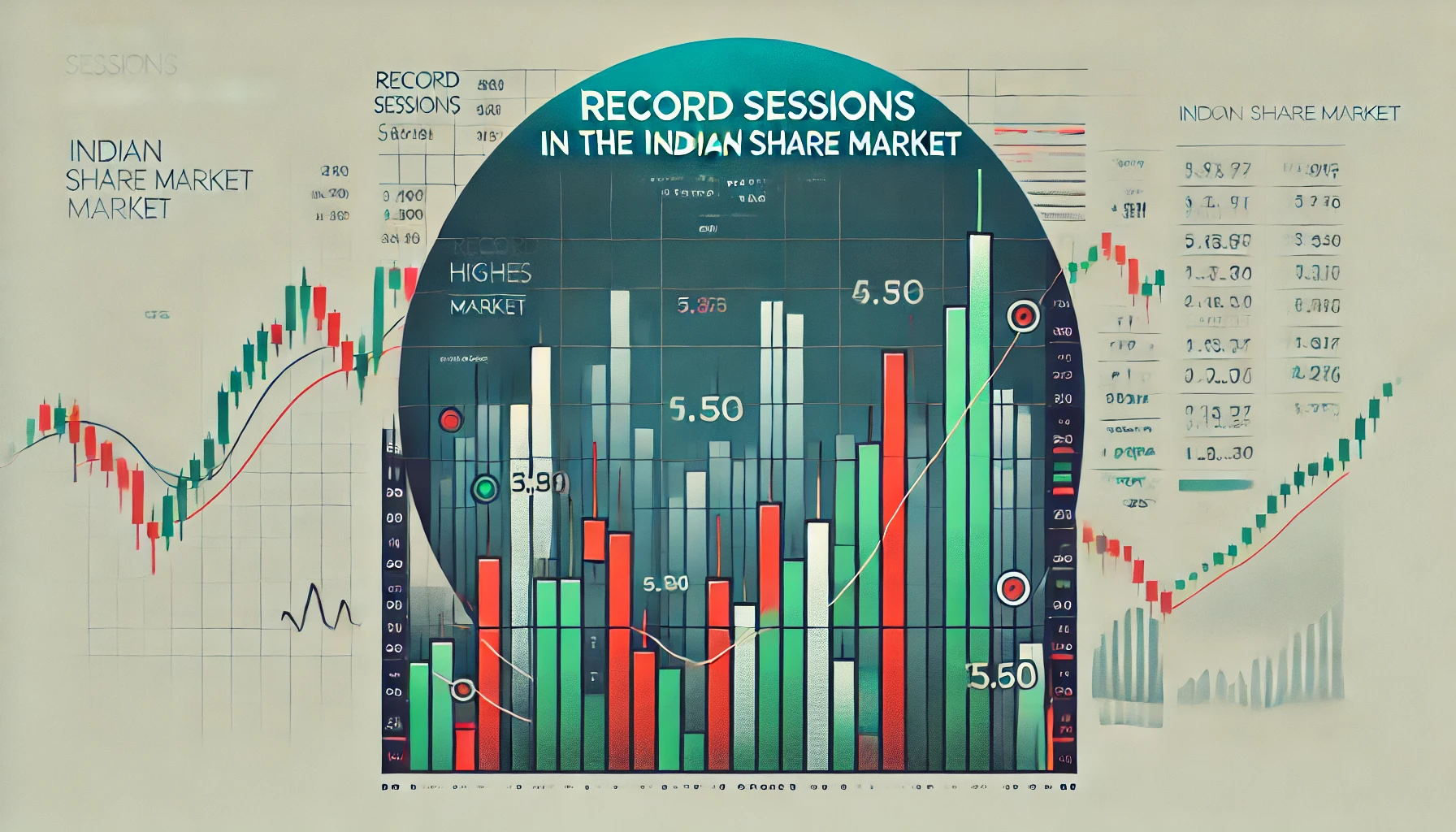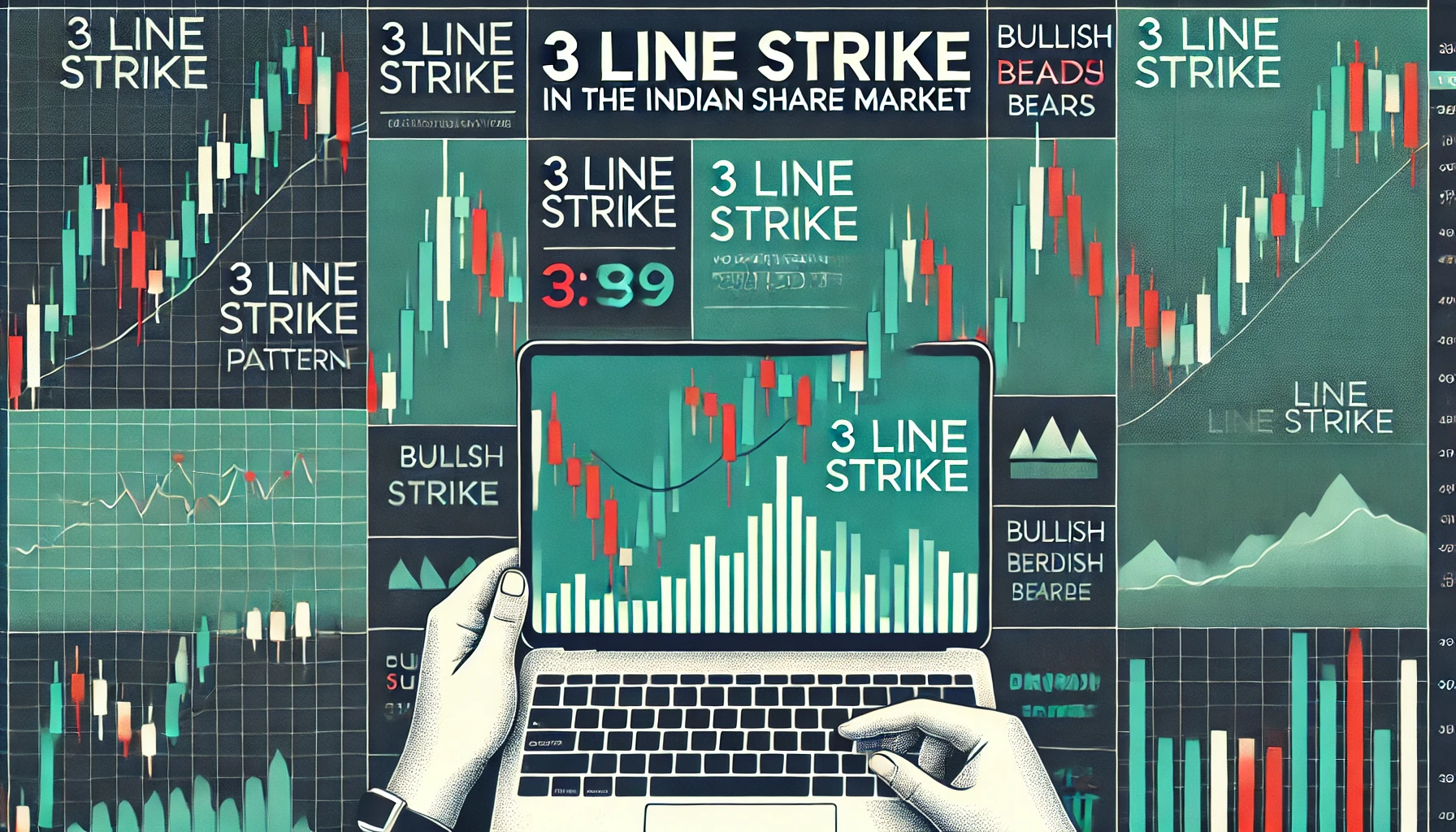The Indian share market is known for its dynamic nature, attracting millions of traders and investors seeking profit opportunities. To succeed in this ever-changing market, one needs the right tools and strategies. Among the most effective tools for analyzing price trends and making informed trading decisions is the EMA (Exponential Moving Average) candlestick chart.
This blog will delve into the importance of the EMA candlestick chart in the Indian share market, explore how it can be used for trading, and provide historical data to give context to its real-world application.
What is an EMA Candlestick Chart?
The Exponential Moving Average (EMA) is a type of moving average that gives more weight to recent prices, allowing it to respond more quickly to price changes than the Simple Moving Average (SMA). Traders often use it to determine the market’s momentum and potential reversals in trend direction.
A candlestick chart visually represents price movements, with each candlestick displaying the stock’s open, high, low, and close prices for a specific time period. When combined with the EMA, traders can identify entry and exit points with greater precision.
Components of EMA Candlestick Chart:
- Candlesticks: Represent daily price movements with the open, high, low, and close of the stock price.
- EMA Line: A smooth line that tracks the average price over a set period, giving more importance to recent data.
- Trends and Reversals: The intersection of the price and EMA lines helps identify bullish or bearish trends.
| Key Terms | Definition |
|---|---|
| Candlestick Chart | A chart that shows the open, close, high, and low prices of an asset. |
| Exponential Moving Average | A moving average that gives more weight to recent price data. |
| Bullish Crossover | When the price crosses above the EMA, indicating potential upward movement. |
| Bearish Crossover | When the price drops below the EMA, signaling a possible downtrend. |
Historical Importance of EMA in Indian Stock Trading
To understand the impact of the EMA candlestick chart, we can look at specific events in the Indian share market. The EMA chart has historically provided traders with accurate signals during critical periods, helping them predict the direction of stock prices.
Case Study: Nifty 50 Performance in 2008
During the 2008 financial crisis, the Nifty 50, India’s benchmark stock index, experienced a major crash. Traders who used EMA candlestick charts were able to identify the downtrend early and reduce losses.
Below is the historical data showcasing the difference between the EMA and SMA during the Nifty 50’s decline in 2008.
| Date | Price | 10-Day EMA | 10-Day SMA |
|---|---|---|---|
| 01-Jan-2008 | 6,000 | 5,950 | 5,980 |
| 15-Jan-2008 | 5,700 | 5,640 | 5,680 |
| 01-Feb-2008 | 5,300 | 5,200 | 5,250 |
| 15-Feb-2008 | 4,800 | 4,760 | 4,780 |
| 01-Mar-2008 | 4,500 | 4,460 | 4,470 |
From the data, it is clear that the EMA responds faster to price changes compared to the SMA, providing timely signals that traders can act on.
How to Use EMA Candlestick Chart in Trading
1. Identifying Trends
The most common use of the EMA is to identify trends. When the price is above the EMA line, it signals an uptrend, whereas a price below the EMA indicates a downtrend. This simple indicator helps traders decide when to enter or exit a trade.
2. Crossovers
A popular strategy in the Indian share market is the EMA crossover strategy. When a shorter-term EMA crosses above a longer-term EMA, it signals a bullish trend, known as a “golden cross.” Conversely, when the shorter-term EMA crosses below the longer-term EMA, it signals a bearish trend, known as a “death cross.”
| EMA Crossover Strategy | Action |
|---|---|
| Golden Cross | Buy Signal |
| Death Cross | Sell Signal |
3. Support and Resistance Levels
The EMA line also acts as a dynamic support or resistance level. For instance, during a strong uptrend, the stock price may repeatedly bounce off the EMA, acting as a support line. Similarly, during a downtrend, the EMA can act as a resistance level.
EMA Candlestick Chart in Indian Share Market
Now let’s take a look at how EMA candlestick charts can be applied to some of the most popular stocks in the Indian share market. We’ll consider historical data from stocks such as Reliance Industries, Tata Consultancy Services (TCS), and HDFC Bank.
Reliance Industries: An EMA Analysis
Reliance Industries, one of India’s largest conglomerates, has seen significant price movements over the years. By applying the EMA candlestick chart, traders can pinpoint periods of bullish and bearish trends.
| Date | Price | 10-Day EMA | 20-Day EMA | 50-Day EMA |
|---|---|---|---|---|
| 01-Jan-2020 | 1,480 | 1,500 | 1,520 | 1,530 |
| 01-Feb-2020 | 1,700 | 1,690 | 1,680 | 1,650 |
| 01-Mar-2020 | 1,200 | 1,250 | 1,280 | 1,310 |
| 01-Apr-2020 | 1,600 | 1,590 | 1,570 | 1,550 |
In March 2020, the EMA showed a clear bearish trend when the stock price of Reliance dipped below the EMA lines, alerting traders of a potential downtrend. However, by April, a bullish crossover was evident, indicating a recovery.
EMA Settings for Different Trading Styles
The period used for the EMA can greatly affect trading strategies. Here are some common settings:
| Type of Trader | EMA Setting |
|---|---|
| Day Traders | 9 or 12 periods |
| Swing Traders | 20 or 50 periods |
| Long-Term Investors | 100 or 200 periods |
Using Multiple EMAs for Confirmation
Many traders use multiple EMAs (e.g., 10-day, 20-day, and 50-day) to confirm trends. A shorter EMA crossing above a longer EMA is considered a confirmation of a bullish trend, while a crossover below is considered bearish.
For example, a trader might use a combination of a 10-day, 20-day, and 50-day EMA to confirm whether the price of a stock like HDFC Bank is truly in an uptrend.
Combining EMA with Other Indicators
While EMA is a powerful tool, it works best when combined with other indicators. Popular options include:
- Relative Strength Index (RSI): Helps identify overbought or oversold conditions.
- Moving Average Convergence Divergence (MACD): Highlights trend changes and momentum.
By using these indicators in tandem with the EMA, traders can make more informed decisions, reducing the likelihood of false signals.
EMA Candlestick Chart: Advantages and Limitations
Advantages:
- Responsive to Price Changes: EMA reacts quickly to recent price movements, making it ideal for fast-moving markets.
- Trend Identification: EMA helps traders identify trends early, which can be crucial in a volatile market like India’s.
- Versatile: Works well across different timeframes, from intraday to long-term investments.
Limitations:
- Whipsaws: In sideways markets, EMA may generate false signals due to frequent crossovers.
- Lagging Indicator: Despite its responsiveness, EMA is still a lagging indicator and may not always predict trend reversals in time.
Conclusion: Mastering EMA for Better Trading in Indian Markets
The EMA candlestick chart is an indispensable tool for traders and investors in the Indian share market. By understanding its applications, combining it with other technical indicators, and using historical data for analysis, traders can improve their chances of making profitable decisions.
For those new to the market, starting with basic EMA settings and observing how the indicator reacts to price movements is a good strategy. As you grow more comfortable with the tool, you can begin to incorporate more advanced strategies, such as using multiple EMAs and other technical indicators, to maximize your trading potential.
With proper risk management and a clear understanding of the EMA candlestick chart, you’ll be better equipped to navigate the complexities of the Indian share market.

What is the TRIN stock market indicator?
The TRIN (Trading Index), also referred to as the Arms Index, is a technical analysis …

Record Sessions
The Indian share market is a dynamic and volatile space where major highs and lows …

3 Line Strike
Candlestick patterns are a vital tool for traders in the stock market, offering insights into …

3 White Soldiers and 3 Black Crows
Candlestick patterns are a key element of technical analysis in stock trading, offering clear signals …

Gapping Doji
Candlestick patterns are a critical part of technical analysis in the stock market, providing traders …

3 Windows
Candlestick patterns are a vital part of technical analysis, offering traders and investors insights into …

2 Gapping Candles
In the fast-paced world of the Indian stock market, technical analysis plays a crucial role …

3 Inside Down and Up
Candlestick patterns are powerful tools in the world of technical analysis, offering traders insight into …

Bullish and Bearish Belt Hold
Technical analysis is an essential part of trading in the Indian share market. Candlestick patterns, …

Piercing and Dark Cloud Cover
In the ever-evolving Indian stock market, candlestick patterns are crucial for traders aiming to predict …

Double Doji
Candlestick patterns have long been a favored tool for technical traders to forecast market movements. …

Rising and Falling Windows
In the world of technical analysis, candlestick patterns are vital tools for traders to anticipate …

Tweezer Top and Bottom
In the fast-paced world of the Indian share market, traders use technical analysis tools to …

Morning Star and Evening Star
In the Indian share market, technical analysis is a valuable tool for traders aiming to …

Hammer and Hanging Man
The Indian stock market offers a wealth of opportunities for traders who understand technical analysis. …

Shooting Star and Inverted Hammer
The Indian stock market, with its dynamic nature, presents various opportunities for traders and investors. …

Last Engulfing
The Indian share market is filled with patterns that can help traders make informed decisions. …

Harami
In the world of stock market analysis, candlestick patterns offer valuable insights into price movements. …

Engulfing
The Indian share market is known for its volatility, and traders often rely on technical …

Marubozu
Candlestick patterns are powerful tools used by traders in the Indian share market to analyze …

Spinning Top
The Indian share market, like any other, experiences constant fluctuations due to a multitude of …

Doji
The Indian share market is dynamic, with investors using various tools to gauge stock performance. …

Double Top
In the world of technical analysis, chart patterns are valuable tools that help traders spot …

Tweezer
In the Indian share market, where volatility and price fluctuations are part of daily trading, …

Harami
In the world of technical analysis, candlestick patterns are powerful tools that help traders make …

Heiken-Ashi
Navigating the Indian share market can be challenging due to the inherent volatility and market …

Ichimoku
In the world of technical analysis, few indicators offer the comprehensive insights that the Ichimoku …

Value Charts
In the ever-changing landscape of the Indian share market, traders and investors need tools that …

Money Flow Index
In the Indian share market, identifying trends, understanding momentum, and assessing volume are critical components …

Aroon
In the fast-paced world of the Indian share market, identifying market trends and spotting reversals …

Gator Indicator
In the Indian share market, success is largely dependent on identifying the right trends and …



















